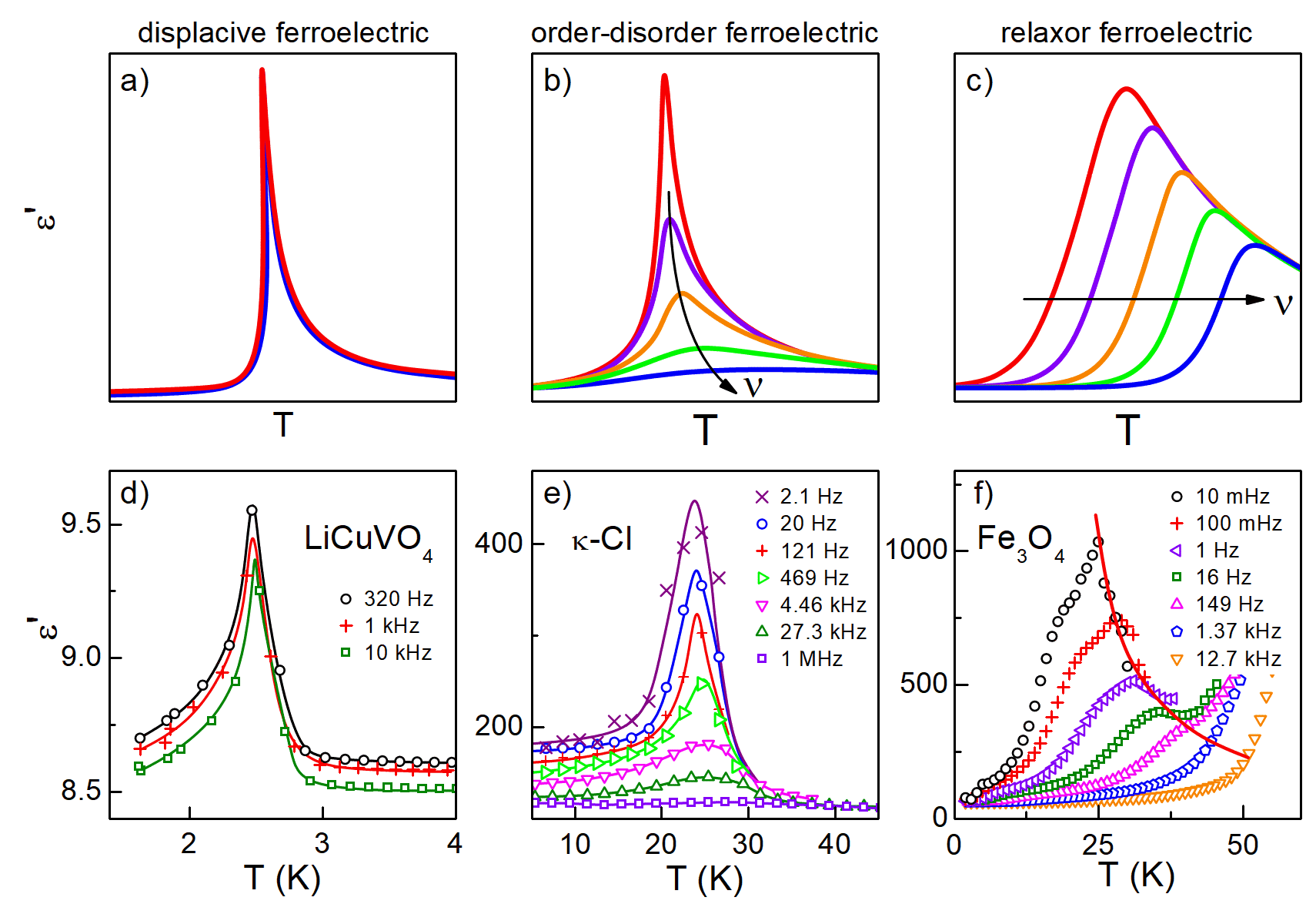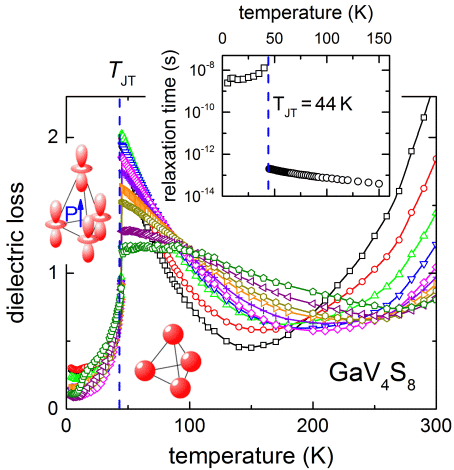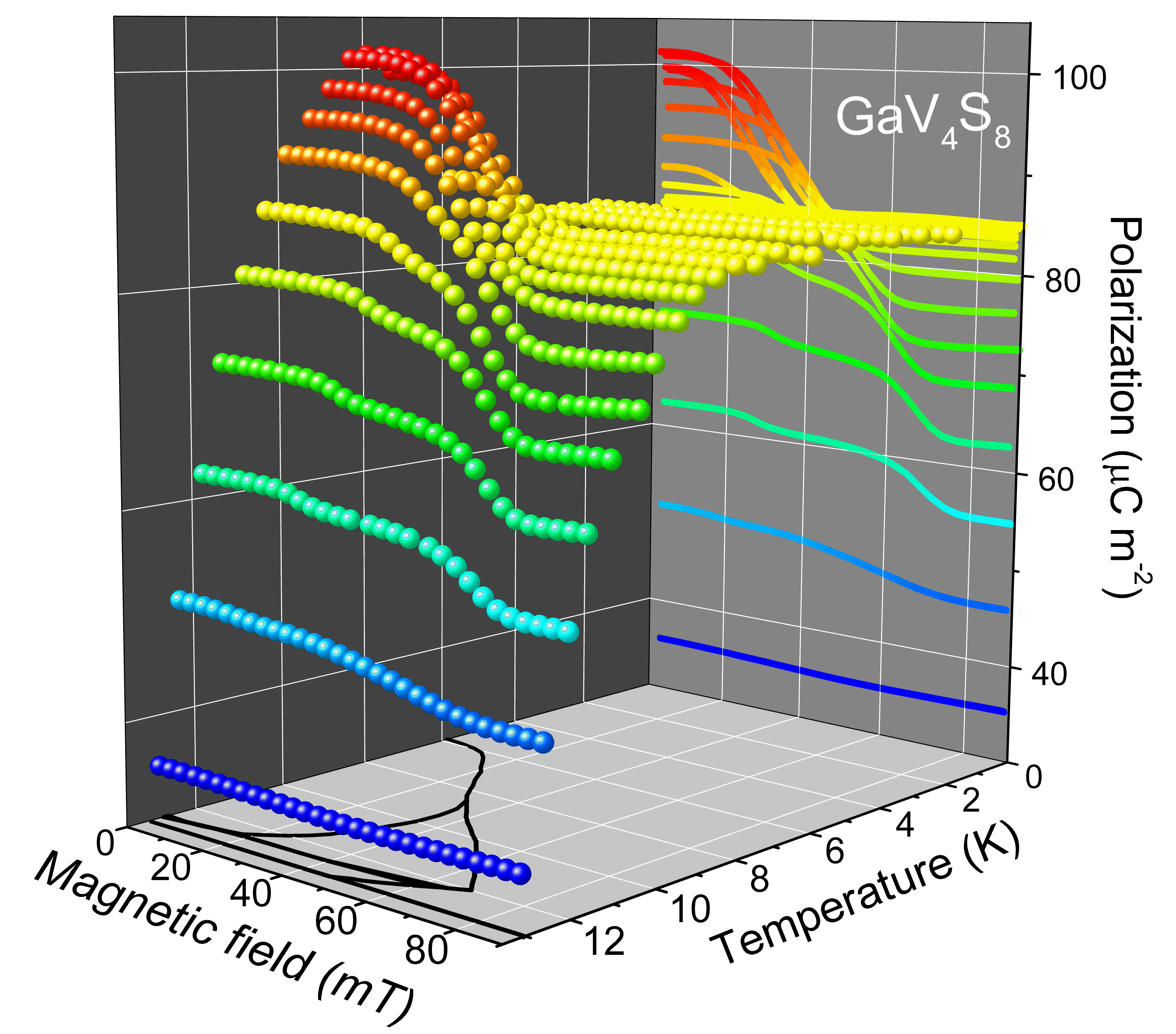| [1] |
Proton glass behavior and hopping conductivity in solid solutions of antiferroelectric
betaine phosphate and ferroelectric betaine phosphite
S.L. Hutton, I. Fehst, R. Böhmer, M. Braune, B. Mertz, P. Lunkenheimer, and A. Loidl,
Phys. Rev. Lett. 66, 1990 (1991).
[PDF]
|
| [2] |
Dielectric spectroscopy in SrTiO3
R. Viana, P. Lunkenheimer, J. Hemberger, R. Böhmer, and A. Loidl,
Phys. Rev. B 50, 601 (1994).
[PDF]
|
| [3] |
Electric-field-dependent dielectric constant and nonlinear susceptibility in SrTiO3
J. Hemberger, P. Lunkenheimer, R. Viana, R. Böhmer, and A. Loidl,
Phys. Rev. B 52, 13159 (1995).
[PDF]
|
| [4] |
Linear and non-linear dielectric spectroscopy on ammonium doped Rochelle salt
U. Schneider, P. Lunkenheimer, J. Hemberger, and A. Loidl,
Ferroelectrics 242, 71 (2000).
|
| [5] |
Relaxor ferroelectricity and colossal magneto-capacitive coupling in ferromagnetic
CdCr2S4
J. Hemberger, P. Lunkenheimer, R. Fichtl, H.-A. Krug von Nidda, V. Tsurkan, and A. Loidl,
Nature 434, 364 (2005).
|
| [6] |
Switching the ferroelectric polarization in the S = 1/2 chain cuprate LiCuVO4 by
external magnetic fields
F. Schrettle, S. Krohns, P. Lunkenheimer, J. Hemberger, N. Büttgen, H.-A. Krug von Nidda, A.V. Prokofiev, and A. Loidl,
Phys. Rev. B 77, 144101 (2008).
[PDF]
|
| [7] |
Relaxations as key to the magnetocapacitive effects in the perovskite manganites
F. Schrettle, P. Lunkenheimer, J. Hemberger, V.Yu. Ivanov, A.A. Mukhin, A.M. Balbashov, and A. Loidl,
Phys. Rev. Lett. 102, 207208 (2009).
[PDF]
|
| [8] |
On the room temperature multiferroic BiFeO3: magnetic, dielectric and thermal properties
Jun Lu, A. Günther, F. Schrettle, F. Mayr, S. Krohns, P. Lunkenheimer, A. Pimenov, V.D. Travkin, A.A. Mukhin, and A. Loidl,
Eur. Phys. J. B 75, 451 (2010).
[PDF]
|
| [9] |
Relaxor ferroelectricity and the freezing of short-range polar order in magnetite
F. Schrettle, S. Krohns, P. Lunkenheimer, V.A.M. Brabers, and A. Loidl,
Phys. Rev. B 83, 195109 (2011).
[PDF]
|
| [10] |
Multiferroicity and skyrmions carrying electric polarization in GaV4S8
E. Ruff, S. Widmann, P. Lunkenheimer, V. Tsurkan, S. Bordács, I. Kézsmárki, and A. Loidl,
Science Advances, 1, E1500916 (2015).
[PDF]
|
| [11] |
Multiferroicity in an organic charge-transfer salt that is suggestive of electric-dipole driven magnetism
P. Lunkenheimer, J. Müller, S. Krohns, F. Schrettle, A. Loidl, B. Hartmann, R. Rommel, M. de Souza, C. Hotta, J.A. Schlueter, and M. Lang,
Nature Mater. 11, 755 (2012).
|
| [12] |
Ferroelectric properties of charge-ordered α-(BEDT-TTF)2I3
P. Lunkenheimer, B. Hartmann, M. Lang, J. Müller, D. Schweitzer, S. Krohns, and A. Loidl,
Phys. Rev. B 91, 245132 (2015).
[PDF]
|
| [13] |
Polar dynamics at the Jahn-Teller transition in ferroelectric GaV4S8
Z. Wang, E. Ruff, M. Schmidt, V. Tsurkan, I. Kézsmárki, P. Lunkenheimer, and A. Loidl,
Phys. Rev. Lett. 115, 207601 (2015).
[PDF]
|
| [14] |
Polar and magnetic order in GaV4Se8
E. Ruff, A. Butykai, K. Geirhos, S. Widmann, V. Tsurkan, E. Stefanet, I. Kézsmárki, A. Loidl, and P. Lunkenheimer,
Phys. Rev. B 96, 165119 (2017).
[PDF]
|
| [15] |
Conflicting evidence for ferroelectricity
G. D'Avino, M. Souto, M. Masino, J.K.H. Fischer, I. Ratera, X. Fontrodona, G. Giovannetti, M.J. Verstraete, A. Painelli,
P. Lunkenheimer, J. Veciana, and A. Girlando,
Nature 547, E9 (2017).
|
| [16] |
Conductivity contrast and tunneling charge transport in the vortexlike ferroelectric Domain Patterns
of multiferroic hexagonal YMnO3
E. Ruff, S. Krohns, M. Lilienblum, D. Meier, M. Fiebig, P. Lunkenheimer, and A. Loidl,
Phys. Rev. Lett. 118, 036803 (2017).
[PDF]
|
| [17] |
Evidence for electronically driven ferroelectricity in a strongly correlated
dimerized BEDT-TTF molecular conductor
E. Gati, J.K.H. Fischer, P. Lunkenheimer, D. Zielke, S. Köhler, F. Kolb, H.-A. Krug von Nidda, S.M. Winter, H. Schubert,
J.A. Schlueter, H.O. Jeschke, R. Valenti, and M. Lang,
Phys. Rev. Lett. 120, 247601 (2018).
[PDF]
|
| [18] |
Orbital-order driven ferroelectricity and dipolar relaxation dynamics in multiferroic
GaMo4S8
K. Geirhos, S. Krohns, H. Nakamura, T. Waki, Y. Tabata, I. Kézsmárki, and P. Lunkenheimer,
Phys. Rev. B 98, 224306 (2018).
[PDF]
|
| [19] |
Chirality-driven ferroelectricity in LiCuVO4
A. Ruff, P. Lunkenheimer, H.-A. Krug von Nidda, S. Widmann, A. Prokofiev, L. Svistov, A. Loidl, and S. Krohns,
Npj Quantum Mater. 4, 24 (2019).
[PDF]
|
| [20] |
Dielectric ordering of water molecules arranged in a dipolar lattice
M.A. Belyanchikov et al.,
Nat. Commun. 11, 3927 (2020).
[PDF]
|
| [21] |
Spin liquid and ferroelectricity close to a quantum critical point in
PbCuTe2O6
Ch. Thurn et al.,
Npj Quantum Mater. 6, 95 (2021).
[PDF]
|
| [22] |
Cooperative cluster Jahn-Teller effect as a possible route to antiferroelectricity
K. Geirhos, J. Langmann, L. Prodan, A. A. Tsirlin, A. Missiul, G. Eickerling, A. Jesche, V. Tsurkan, P. Lunkenheimer,
W. Scherer, and I. Kézsmárki,
Phys. Rev. Lett. 126, 187601 (2021).
[PDF]
|
| [23] |
Relaxor ferroelectricity in the polar M2P-TCNQ charge transfer crystal at the neutral-ionic
interface
J.K.H. Fischer, G. D'Avino, M. Masino, F. Mezzadri, P. Lunkenheimer, Z.G. Soos, and A. Girlando,
Phys. Rev. B 103, 115104 (2021).
[PDF]
|
| [24] |
Antipolar transitions in GaNb4Se8 and GaTa4Se8
M. Winkler, L. Prodan, V. Tsurkan, P. Lunkenheimer, and I. Kézsmárki,
Phys. Rev. B 106, 115146 (2022).
[PDF]
|
| [25] |
Optical, dielectric, and magnetoelectric properties of ferroelectric and antiferroelectric
lacunar spinels
K. Geirhos, S. Reschke, S. Ghara, S. Krohns, P. Lunkenheimer, and I. Kézsmárki,
Phys. Status Solidi B 259,
2100160 (2022).
[PDF]
|
| [26] |
Slow and non-equilibrium dynamics due to electronic ferroelectricity in a strongly-correlated molecular
conductor
T. Thomas, Y. Agarmani, S. Hartmann, M. Kartsovnik, N. Kushch, S.M. Winter, S. Schmid, P. Lunkenheimer, M. Lang, and J. Müller,
Npj Spintronics 2, 24 (2024).
[PDF]
|
| [27] |
Post-synthesis tuning of dielectric constant via ferroelectric domain wall engineering
L. Zhou, L. Puntigam, P. Lunkenheimer, E. Bourret, Z. Yan, I. Kézsmárki, D. Meier, S. Krohns, J. Schultheiß, and D.M. Evans,
Matter 7, 2996 (2024).
[PDF]
|
| [28] |
Ferroelectric and multiferroic properties of quasi-2D organic charge-transfer salts: A review
M. Lang, P. Lunkenheimer, O. Ganter, S. Winter, and J. Müller,
J. Electron. Mater. 54, 5087 (2025).
[PDF]
|



